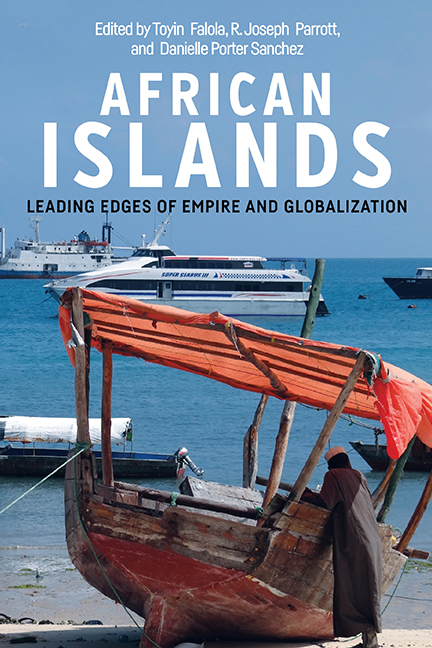Book contents
- Frontmatter
- Dedication
- Contents
- Introduction: Arbiters and Witnesses of Change: Contextualizing Conversations on African Islands
- Part 1 Atlantic Ocean Islands
- 1 The Canaries to Africa: The Atlantic Strategy of “To Be or Not to Be”
- 2 Sugar, Cocoa, and Oil: Economic Success and Failure in São Tomé and Príncipe from the Sixteenth to the Twenty-First Centuries
- 3 The Bijagos of Canhabac Island (Guinea-Bissau)
- 4 An Island in the Middle of Everywhere: Bioko under Colonial Domination
- 5 Cursing in Bioko and Annobón: Repeating Islands that Don't Repeat
- 6 African Ports and Islands during the Second World War
- 7 “Nos lingua, nos kultura, nos identidadi”: Postcolonial Language Planning and Promotion in Cabo Verde and the Cape Verdean Diaspora
- Part 2 Indian Ocean Islands
- Notes on Contributors
- Index
6 - African Ports and Islands during the Second World War
from Part 1 - Atlantic Ocean Islands
Published online by Cambridge University Press: 31 August 2019
- Frontmatter
- Dedication
- Contents
- Introduction: Arbiters and Witnesses of Change: Contextualizing Conversations on African Islands
- Part 1 Atlantic Ocean Islands
- 1 The Canaries to Africa: The Atlantic Strategy of “To Be or Not to Be”
- 2 Sugar, Cocoa, and Oil: Economic Success and Failure in São Tomé and Príncipe from the Sixteenth to the Twenty-First Centuries
- 3 The Bijagos of Canhabac Island (Guinea-Bissau)
- 4 An Island in the Middle of Everywhere: Bioko under Colonial Domination
- 5 Cursing in Bioko and Annobón: Repeating Islands that Don't Repeat
- 6 African Ports and Islands during the Second World War
- 7 “Nos lingua, nos kultura, nos identidadi”: Postcolonial Language Planning and Promotion in Cabo Verde and the Cape Verdean Diaspora
- Part 2 Indian Ocean Islands
- Notes on Contributors
- Index
Summary
This chapter evaluates the role of Africa's coastal waters, ports, and islands during the Second World War and describes the military activity that took place there. In doing so, it offers a unique account of the continent's strategic importance in a global conflict. The generosity of the editors in permitting a substantial word tally enables the chapter to address macrostrategic themes while also detailing their macrolevel permutations. What this means is that the chapter is able to demonstrate connections between strategically important shipping lanes around Africa and the military goods that traversed them, with the airstrips, wharves, jetties, cookhouses, and ammunition storage facilities maintained on African soil that enabled them to function. By looking at African ports and islands as a whole while simultaneously detailing the military infrastructure they contained and the military roles they performed, the whole appears greater than the sum of its parts. This is important because apparently peripheral military activity on, say, an African lagoon or coastal airstrip was always part of a chain of military provision and was directly linked to global logistics and military operations. For example, air cover mounted from bases in the Gambia provided protection for Allied convoys traveling between the Eastern and Western hemispheres, handing over to escort and patrol aircraft bases in places such as Sierra Leone and South Africa as those convoys moved around Africa's coastline. In such complex global military systems as that developed by Britain and its allies in the Second World War, small cogs are just as important as big wheels in enabling the system to operate. The extensive archives charting the development of places such as Bathurst, Mas sawa, and Port Sudan, some of which are used to provide an original archival contribution in this chapter, offer a vivid impression of the complexity, scale, and significance of the infrastructure offered by African ports, vital yet rarely acknowledged in general war literature and even specialist works on topics such as logistics and military operations. The chapter is divided into five sections. An introduction is followed by an explanation of the importance of ports and islands in times of war and the reasons for Africa's strategic consequence during the Second World War.
- Type
- Chapter
- Information
- African IslandsLeading Edges of Empire and Globalization, pp. 170 - 207Publisher: Boydell & BrewerPrint publication year: 2019

